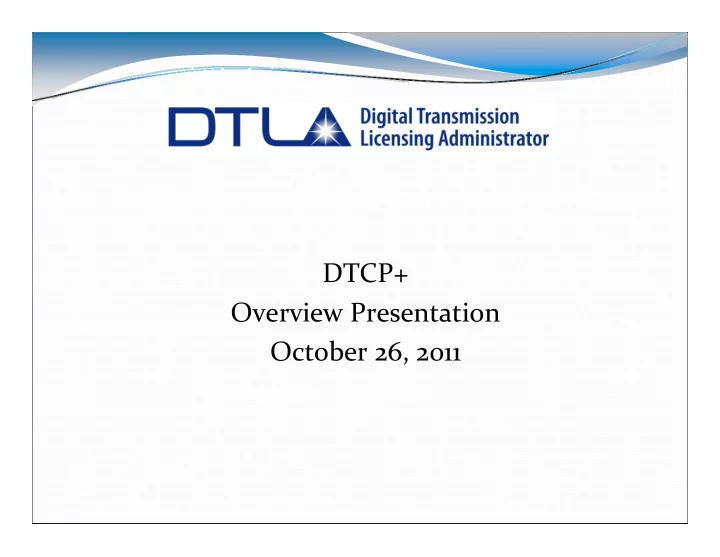

DTCP+ Overview Presentation October 26, 2011
Elements of DTCP+ � DTLA is adding four new capabilities to DTCP, referred to as DTCP+ � Digital Only Token � New “media agnostic” way to carry Content Management Information (CMI) � New Copy Count CMI � New Remote Access capability 2
Digital Only Token � Used to signal that DOT marked video content will only be output via protected digital outputs (no analog video outputs or digital video outputs that allow subsequent analog output). � Designed so that existing DTCP sinks cannot decrypt DOT marked content. � Applicable to “high value” content � FCC Waiver Order (early window access to theatrical films) � Internationally, VOD up to 120 days � Prerecorded content 3
CMI Carriage Requirement � Prior to DTCP+ � Embedded CCI Carriage is format dependant � DTCP has a Descriptor for only MPEG ‐ TS � For DTCP ‐ IP there is an optional media ‐ agnostic Protected Content Packet ‐ Usage Rule (PCP ‐ UR) � PCP ‐ UR is not extensible and only 8 bits remain � DTCP+ � “CMI” is used for the set of DTCP Content Management Information such as CCI, Analog Sunset Token, Digital Only Token, APS, etc. � To carry CMI for existing and new media formats, DTLA is creating an extensible media ‐ agnostic carriage of CMI 4
CMI Carriage Basics � The CMI carriage capability is available to all DTCP transports. � CMI Field is cryptographically linked to transmitted content to prevent spoofing. � CMI Field is extensible, so that additional capabilities can be defined according to Content Participant and Adopter business model needs. 5
Copy Count (CC) � Requirement � Enable DTCP to correctly carry and manage content that has been encoded with a Copy Count. � Can be recorded content or live transmissions � When a copy is made from content marked with CC Count, the count is decremented by 1 and the copy is remarked as NMC. � Full functionality with CC ‐ cognizant sink � Can MOVE a CC copy to a legacy sink 6
CC Transport Examples (1) � Given CC Count(5) a single copy is made and transported to a connected sink. � Copy is marked as No ‐ More ‐ Copies (NMC) � Source decrements CC Count by one. Before CC Count (5) Source Sink After NMC CC Count (4) Source Sink � Simple transport of CC marked content from one content AV server to another. Before CC Count (5) Source Sink After CC Count (5) Source Sink 11
CC Transport Examples (2) � Given CC Count (5) the source has been requested by consumer to make a copy and send it to two different devices � Each copy is remarked as NMC � The Source decrements the CC Count by two Before Sink 1 CC Count (5) Source Sink 2 Transmission Sink 1 CC(1) CC Count (3) Source Sink 2 CC(1) After Sink 1 NMC CC Count (3) Source Sink 2 NMC 8
CC Transport Examples (3) � Permit DTCP source functions to manipulate CC marked content and split it between sinks at consumer request via a move function � Example 1, CC Count (3) where � Sink 1 receives NMC After Transport NMC � Sink 2 receives CC Count (2) Sink 1 No content Source Sink 2 CC Count (2) � Example 2, CC Count (5) where � sink 1 receives CC Count (3) After Transport CC Count (3) Sink � sink 2 receives CC Count (2) No content Source Sink CC Count (2) 9
Remote Access (RA) � Basic Rules � Remote Connection AKE 10
Remote Access Basic Rules (1) � Source devices may permit remote access to content by 1 and only 1 sink device at any one time. Source Sink 11
Remote Access Basic Rules (2) � Remote Access always available for stored No More Copies and EPN content. � Permitted for live transmissions carrying an upstream indicator. Source Sink 12
Remote Access Basic Rules (3) � Local access from the source device to other devices on the home network may be performed simultaneously with remote access, and… Source Sink 13
Remote Access Basic Rules (4) � A product that is actively remotely connected can be a source to other sinks on home/personal network in the remote location. But ‐‐ Source Sink 14
Remote Access Basic Rules (5) RA RA RA RA RA � No RA is permitted of any content during its reception from a DTCP source function. � This prevents daisy chaining when receiving content from a DTCP Source function via: � an RA connection (Remote) � a normal connection (Local) Source Sink 15
Remote Access Basic Rules (6) � Devices at remote location cannot copy remotely accessed content � Devices at remote location can receive Move and Copy Count content from source Display, Move, CC (allowed) Copy (not allowed) Source Sink 16
Remote Sink Registration � Source devices may only add a sink device to their remote sink registry using “ local remote registration ” � Source devices perform DTCP authentication and register sink devices locally, before the sink may gain remote access. � “ Local remote sink registration ” process includes � Successful local authentication of device with source � Passing current additional localization checks (RTT, TTL) � Remote sink registry is available for up to 20 devices. Consumer can remove any devices from the list, but additions are permitted only if the connected device successfully concludes the remote sink registration process. 17
DTCP+ Overview Presentation October 26, 2011 Thank you! 18
Recommend
More recommend